

"Piccadilly" ranks very high amongst English silent
films, being, undoubtedly, of its type, the best produced in the
country. B.I.P. seem to have spared no trouble or expense to secure
quality in every department - the special story, the lavish sets,
the excellent cast and the famed foreign technicians (though these
started the line of jokes about "English Films") could
not have failed to appease any carping critic who might have been
called in to approve them. Indeed, one might say that the "international"
methods of Hollywood whereby the World's talent was ruthlessly
purchased regardless either of cost or of the ultimate fate of
that talent were being copied so meticulously that success must
be assured. Average success was duly achieved, but we have to
log two disappointments - a major one that the director of "Vaudeville"
fell so far short of this previous triumph, and a minor one that
a rather shabby trick title is used. An excellent film is yet
to be made about Piccadilly - one recalls Ruttmann's "Berlin"
(1927-28) - but "Piccadilly" is concerned with the affairs
of a gentleman who "happens" to be the manager of the
"Piccadilly Club," one Valentine Wilmot.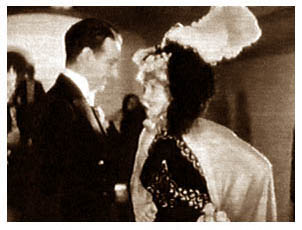
Mabel and Vic are the star dancers at this Club. The former is Wilmot's wife, and the latter becomes over-familiar with her and so is sacked.
Visiting the kitchens regarding a complaint, Wilmot sees a Chinese girl, Shosho, doing an impromptu dance.
Business falls off since Vic's departure, and, in desperation, Wilmot signs Shosho as a new attraction. She stipulates the purchase of an expensive costume and the engagement of her fiancé Jim as accompanist. They duly appear with sensational success.
Wilmot drives Shosho home. Mabel is overcome with pique and jealousy. Wilmot and Shosho foregather in Limehouse. She hands over her apartment key . . .
Placards announce, "Murder of Shosho." In court, Jim states that Wilmot entered the apartment and that he went away leaving Wilmot with Shosho. Wilmot admits ownership of the revolver found by the body. Mabel then interrupts to testify. She followed them to Limehouse - was let in by Jim after Wilmot left - pleaded with Shosho to keep away from Wilmot - threatened her with Wilmot's revolver when she refused - fainted. This contradiction regarding Jim's presence causes the Coroner to demand his recall. But he has shot himself. He gasps out his story of Shosho's rebuff, their struggle, the dropped revolver, the fatal shot.
Placards announce, "Shosho Confession and Suicide" - and "Life Goes On."
The banality of this story equals that of "Vaudeville" ("Variety"). But unhappily it lacks the redeeming features of the carefully chosen action to explain details - and of action as opposed to dialogue at the key points of the narrative. Thus, Mabel admits her jealousy in a slow-tempo sequence full of titles, whereas Boss learns the truth in the café in a quick tempo sequence and only one title. Again, explanatory titles slow down the Court scene opening reel 3 and destroy the surprise element in the climax, whereas in "Vaudeville," we imagine the trapeze accident and are kept taut with suspense right through the performance and the actual killing.
These examples illustrate the very fundamentals of film construction. They are equally applicable to talkies - the more so just now when the art of quick cutting for a fast, dramatic rhythm is being lost amid the craze for the wandering camera and the reliance on a noisy soundtrack for dramatic effect (e.g., "The Mask of Dimitrios," 1944, by Jean Negulesco, a new director who doesn't appear to have heard of montage, though he knew and inappropriately copied the wavy mixes of Coward's "In Which We Serve.")
The trade reviews for 'Piccadilly' were embarrassingly eulogistic . . .
". . . supremely well played and brilliantly produced . . . Certain attraction for any house . . . the most striking film issued recently from a British studio and reflects every possible credit on all concerned in its making . . . will appeal to the most critical . . . The entire cast is perfect in every detail." (Bioscope, Feb. 1929)
As was usual, a year elapsed between the film's premiere and general release so that contemporary releases included only one important silent film, "The Wonderful Lie," but four well-remembered talkies - "Alias Jimmy Valentine" (by Jack Conway with William Haines), "Bulldog Drummond" (by F. Richard Jones with Ronald Colman, Joan Bennett, Lilyan Tashman), "High Treason" (by Maurice Elvey with Benita Hume, Jameson Thomas) and "Innocents of Paris" (by Richard Wallace with Maurice Chevalier).
It should be noted that, as with many late silent films, "Piccadilly" was shot (and must be projected) at about 20 frames per second.
The establishing exterior night L.S. of the Piccadilly Club
façade is spoiled by the passing of a bus carrying an advertisement.
Well-lit and imposing interior long shots follow. Then C.S. wine
bottle mixes to M.S. audience expectant. A card introduces Mabel
and Vic. Orchestra strikes up. In full L.S. from high angle, the
two dancers enter, 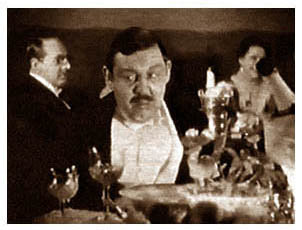 down the double stair
from the balcony in the background of this excellent set. Several
rather uninspired shots cover the dancers, then CM.S. discovers
Jameson Thomas standing halfway up the stair, looking suave. Two
men diners discuss him, so that he is introduced as Wilmot the
Manager in a dialogue title. One of them further remarks "-
he also started Mabel, and made her too. You can imagine the rest."
The cutting from them to Wilmot is timed to perfection.
down the double stair
from the balcony in the background of this excellent set. Several
rather uninspired shots cover the dancers, then CM.S. discovers
Jameson Thomas standing halfway up the stair, looking suave. Two
men diners discuss him, so that he is introduced as Wilmot the
Manager in a dialogue title. One of them further remarks "-
he also started Mabel, and made her too. You can imagine the rest."
The cutting from them to Wilmot is timed to perfection.
The little episode of Laughton and the dirty plate is very nicely done. He stops the waiter, who is on the point of serving him - sends for the head waiter who deprecatingly hovers. Tracking shots cover the amused reactions of other diners and the anxiety of the temporarily forgotten performer Mabel. And best of all is Laughton (now thoroughly worked up) banging his table with rhythmic insistence. A clean plate is carefully placed before him. The dance ends. Applause is covered in shots of two corners of the restaurant connected by a fast pan. A cut would have been better. Vic makes a great show of kissing his partner's arm and shoulders. They separate and run up the stairs, the camera panning ahead of rest at CM.S. - Wilmot, disapproving - again a straight cut would have been better. One vaguely feels, having in mind the period that his specially imported cameraman thought he was expected to keep his camera moving about and resolved to do so at all costs. This disease recurs in "The Mask of Dimitrios" as the camera is wheeled right round Lorre and Greenstreet for no earthly reason . . . unless, as one fears, it was an attempt to infuse interest (?) into a decaying situation clogged with dialogue.
Wilmot proceeds to the kitchen (allowance must be made for continuity breaks due to pruning), retrieves the famous dirty plate, proceeds (track) to the scullery where a steamy L.S shows Shosho dancing and no work being done. A beautifully lit CM.S. tilts from top to toe of the dancer and then pans to admiring colleagues beside her. Wilmot stands by the door. The alarm is given by a man who expresses dismay and then turns to see what has dismayed him - thoroughly bad direction of a bit player. Conversely, there is an excellently directed shot of three dishwashers, now assiduously working, one of whom raises guilty eyes for a peek at the boss. Wilmot hands over the offending plate to the supervisor who duly lays down the law in a grand gesture. In a corridor, Wilmot meets Mabel and pauses to regret the affair.
Wilmot sacks Vic by handing over a prim note which is rather ludicrous. The effect of Vic's absence is excellently shown by a C.S. of the table reservations list, bare of bookings. This point is then laboured in a well-acted, but over-titled, office sequence with Wilmot and Santos, the head waiter, who demands a new attraction . . .
Again, with good cause-and-effect, a M.S. fades in to discover Shosho being shepherded into Wilmot's office. She sits at a distance. Quite ingeniously, the interview is shown from her end only - with medium close-ups of her and the titles giving the replies to questions which are merely suggested. Then Wilmot gets up and paces about, and after more titles it is agreed to buy a costume from the Limehouse shop suggested by Shosho. Wilmot's indecision at this gamble with the unknown girl is well portrayed by his pacing, carried through the shots of Shosho, and with cut-in, low-angle close-ups as he pauses or turns.
Wilmot reaches the Limehouse restaurant where chopsticks
are being plied. The waiter directs him to the inner shop. The
camera follows him down a passage and - a neat idea - swings with
the door he pushes open to show both him entering and the "shop"
wherein Jim is seated at work. A curtain parts to reveal the Boss.
Two shots cover this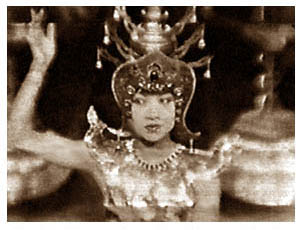 showing the parting
curtain from Wilmot's and then the Boss's eye. This is presumably
for dramatic emphasis but is wrong, because it gives a sudden
start of quick rhythm to a sequence that should be slow, i.e.,
with lengthy shots. A slow track up to Wilmot would be preferable,
with a dramatic climax (but no cut) as the curtain is parted.
showing the parting
curtain from Wilmot's and then the Boss's eye. This is presumably
for dramatic emphasis but is wrong, because it gives a sudden
start of quick rhythm to a sequence that should be slow, i.e.,
with lengthy shots. A slow track up to Wilmot would be preferable,
with a dramatic climax (but no cut) as the curtain is parted.
Shosho appears through a curtained recess. Amid much slinky walking about and one stupid C.S. of Wilmot, moustache-stroking (all excellently lit, and the "shop" is a grandly realistic set), Jim tries on the costume selected by Shosho. There is some price haggling, but Shosho refuses to appear without that particular costume, and Wilmot pays. Emboldened, she further demands Jim as accompanist, and again succeeds. The last long shot, with the Boss pleasedly bowing, is really admirable.
Inexplicably, we mix to Wilmot playing the piano at his own rehearsal room. Correctly, fades should have punctuated these sequences. Wilmot compliments Mabel on the new dance she has just rehearsed, then explains about Shosho, to be met with a very unfavourable (and very sub-titular) reaction. Fade out on C.S. Mabel . . . (and in this case a mix could serve!)
. . . Fade in, M.S. Jim playing. CM.S. (with pan and tilt as required and executed rhythmic smoothness with perfection) Shosho dances - then M.S., then L.S., then full L.S., the Piccadilly Club floor now decorated with huge revolving glass spheres of light, intermittently flashing. Here the design, lighting and camera work are absolutely beyond reproach. Wilmot watches as before, half-way up the stair, circles of light drifting past him. Mabel also watches from the back, not so pleased. Pointedly, L.S. of a burst of applause from a group of standing men is cut to full C.S. of her annoyance. The dance ends with a full L.S. from high angle, the whole staff of waiters watching in the background - a nice touch.
With startling abruptness (in this pruned version), we cut to C.S. of newspaper headlines announcing Shosho's success. She reads with delight, though the little sequence is so badly handled that no help is given to the actors. One C.S. has inexplicable lines of light on it, and a completely superfluous and largely out-of-focus tracking shot hovers past Shosho up the newspaper. Then, wrongly again, fade out and fade in to C.S. Mabel's hands crumpling the paper and her feet stamping it. And, as if it were not already over obvious, pan to a M.S. glimpse of her, again out of focus, before quick fade out. Consider another comparison scene, that of Emil Jannings comparing his wife to Bertha Marie in reel 2 of "Vaudeville" - and so prove the merits of keeping the camera still.
 Shosho asks Wilmot to drive her
home. He eyes a note (these notes!) received from Mabel, asking
him to come, but decides on Shosho. In the chauffeur-driven Rolls,
Shosho speaks to a glum, left-behind Jim - and then, sitting remotely
from Wilmot, they drive off.
Shosho asks Wilmot to drive her
home. He eyes a note (these notes!) received from Mabel, asking
him to come, but decides on Shosho. In the chauffeur-driven Rolls,
Shosho speaks to a glum, left-behind Jim - and then, sitting remotely
from Wilmot, they drive off.
The Limehouse street exterior is good both in design - a low arch spans the road, the lighting is good, and it happily lacks the appearance of having been built the day before. In choice and grouping of extra players, they look and act the part - in marked contrast to the amazing figures draped 'round the walls of the Paris night-haunt in "The Rat" (1925). One CM.S. covers the alighting from the car, Shosho's "Thank you. Goodnight, Mr. Wilmot," and his return into the car - fade out.
Fade in C.S. of a turning door knob unnecessarily precedes
Wilmot's return to Mabel. She looks up snootily from a book .
. . The sequence that follows is so thoroughly bad that it merits
quoting as an object lesson:
(a) CM.S. He sits on couch beside her, takes her hand to kiss,
but she withdraws it and says . . .
(b) TITLE "- and you have the nerve to try and kiss me."
(c) C.S. (over her shoulder) he looks dismayed.
(d) L.S. He leans towards her, but she haughtily gets to her feet
and turns her back on him. He also rises. She extends a hand towards
him, showing . . .
(e) C.S. . . . wedding ring just visible behind ornate dress ring.
(f) CM.S. She turns her back on him again. He says. . . .
(g) TITLE "Shosho begged me to drive her home - Really, I
couldn't refuse the girl."
(h) CM.S. (as f) . . . he says. She haughtily counters. He protests
. . .
(i) TITLE "You're quite wrong, my dear. I didn't even see
the outside of the house. She insisted on leaving me at the corner."
(j) CM.S. (as f) Mabel therefore remarks . . .
(k) TITLE "Oh! So she had to insist."
(l) CM.S. (new angle) She walks away from him.
(m) M.S. She stands apart . . .
(n) C.S. . . . rather moodily . . . walks out of frame.
(o) CM.S. Wilmot suddenly laughs, teases her.
(p) TITLE "Mab, darling! Surely you aren't jealous!"
(q) C.S. She turns and blurts out . . .
(r) TITLE "That's just what I am! Jealous! Jealous! - and
it seems to me I've got good reason to be. Never will I dance
in the Piccadilly again!"
(s) C.S. (as q) She says adding . . .
(t) TITLE "Please go! I ask you to go - now!"
(u) CM.S. (as o) Wilmot looks surprised, walks forward . . .
(v) CM.S. Mab leans against a cabinet, one hand on hip. Wilmot
walks up, touches her arm - she edges away, walks away from him.
He pauses, then follows.
(w) L.S. They both open their bedroom doors, hover irresolutely
on the thresholds, then droop in. The doors close . . . slow fade
out.
The only redeeming feature of this sequence is the beautiful composition and arrangement of shot (v) taken from high angle and with a light fitting crossing the foreground. Reading the seven titles one after the other will immediately indicate the entire meaning of the sequence, so that, in effect, the pictures are superfluous! Their redundant verbosity, their unbalance in length (the longest, (r), should come at a dramatic moment of quick cutting, yet its length demands 250 frames!), and the absolute imbecility of (t) fills the present writer with astonished dismay. The cutting is equally incompetent and dilatory. Both shots (n) and (v) are held for several frames after the actor's head is no longer visible, and the dreary shot (f-h-j), which is one shot with three titles, is really depressing. The complete failure of the actress to infuse any sympathy or power into what is meant to be a dramatic scene must be partly attributed to this faulty montage, which, in turn, is partly due to the failure of the director (and scenario writer) to provide appropriate film strips. In addition, there are trivial errors such as Wilmot saying, "Mabel" in shot (o) whereas title (p) says, "Mab" - and the oddity of both the bedroom lights being on when the doors are opened . . . though this may have been dramatic licence demanded by the cameraman.
A few shots, all nicely arranged, cover Wilmot and Shosho (holding hands, rather ludicrously) in a Limehouse haunt. The latter remarks, "You see, this is our Piccadilly" - again the confusion of the meaning of the film's title.
A very lengthy tracking shot shows Wilmot and Shosho walking
under the arch previously shown. They pause, held in CM.S. Then
in one shot we have C.S. Shosho puts her hand on Wilmot's. Tilt
to C.S. Wilmot, startled. Tilt back to C.S. hand, removed to show
key left in Wilmot's hand. The titles are jerk-tilts, but cuts
would have been better, especially as the camera gives a sickly
lurch during the LC.S. of Wilmot. The last shot is unusual - a
L.S. of the pair by the arch. A lorry slowly pulls in, obscuring
our view 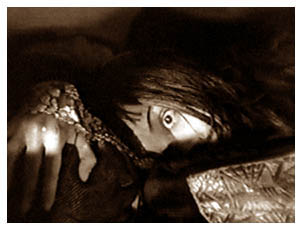 of them. And when
the lorry has passed by, they are no longer in sight. There is
nothing theoretically wrong with this trick, designed to leave
open their subsequent movements. But it is spoiled for those who
recall Harold Lloyd's identical gag in his attempts to elude the
suspicious cop at the start of the climb in "Safety Last!"
(1923).
of them. And when
the lorry has passed by, they are no longer in sight. There is
nothing theoretically wrong with this trick, designed to leave
open their subsequent movements. But it is spoiled for those who
recall Harold Lloyd's identical gag in his attempts to elude the
suspicious cop at the start of the climb in "Safety Last!"
(1923).
However, we are well and dramatically pulled back to reality
by L.S. of posters yelling the murder. The tracking shot is irritatingly
superfluous. The headlines indicate tomorrow's Coroner's Inquest
- from which we mix to a fine L.S. of the Coroner's court, then
C.S. of the Coroner. Six titles cover Jim's evidence and make
things look dim for Wilmot who is next taken. Four more titles
admit it is his gun. Then the Coroner says, "Gentlemen, there
seems to be no further evidence. You may now consider your verdict."
Interruption comes from veiled Mabel, however, and after three
more titles, we flash back to her story. M.S. her shadow dodges
out of sight. L.S. (amid swirling smoke/fog) Wilmot exits from
a house, she thereupon (after argument with Jim in excellent low-angle
C.S.) enters. Shosho reclines on a divan. Her eyes slowly open.
Cut to M.S. of Mabel entering, seen from her eyes, the opening
lids being represented by two shaped shutters - nicely done but
wrong in a story told by Mabel. Four titles cover Shosho's refusal
to give up Wilmot, then . . .
(a) C.S. Mabel's bag. She opens it, takes out pistol
(b) C.S. Shosho's eyes dilate, she covers her face. . .
(c) FC.S. . . . her staring eyes seen through the transparent
dress . . .
(d) C.S. The sheathed dagger hanging nearby - her hand takes it
. . .
(e) C.S. She holds it by her . . .
(f) C..S. Mabel looks in horror . . .
(g) C.S. (as e) She bares the dagger - its shadow passed her staring
eyes. . .
(h) C.S. Mabel levels her pistol, wavers. The screen darkens.
The darkness clears and Mabel collapses. Fade out.
Back in court, five more titles convince the Coroner that
there's perjury somewhere. Then comes the great message. "The
Chinese boy has shot himself. He's lying beside the girl in the
mortuary." They troop with dignity into the mortuary where
Jim recovers sufficiently to tell his tale. After an introductory
title, he challenged Shosho, and she put him off. This is well
conveyed without titles. Then Jim gets his hands on her throat,
and as they sway, struggling, the camera swings swiftly with them,
excellently done. One shot silhouettes them against a glass partition.
Shosho momentarily escapes, then we see Jim's hand slide into
the edge of the frame. . . he pins her down, starts to strangle
her, but is once more pushed away onto the floor. His hands find
the dropped pistol.
(a) C.S. Shosho regards him in terror (Only one eye and hand are
visible)
(b) CM.S. Jim looks up at her, holding pistol.
(c) C.S. (as a) the eye . . . then she jerks away . . .
(d) C.S. (low angle) . . . and cowers against the wall . . .
(e) C.S. (high angles) Jim, raises pistol, fires (one blank frame
at shot).
(f) C.S. (as d) Flash occurs after six frames. Shosho's eyes close
. . .
(g) C.S. (as e) Jim very slowly lowers the pistol.
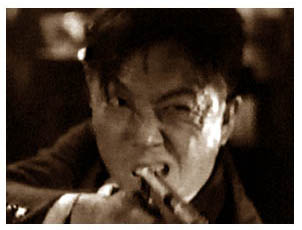 (h) C.S. (as f) Shosho falls sideways
out of the frame.
(h) C.S. (as f) Shosho falls sideways
out of the frame.
Slow fade out.
Slow fade in
(i) CM.S. Posters proclaiming, "Shosho: confession and suicide"
(j) M.S. Sandwich men walk by carrying poster advertising a show
- "Life Goes On"
Slow fade out
. . . and thus the film ends, with a last shot which is crudely cynical and far removed from the famous narrative last shot of "Vaudeville." A later attempt by Dupont, also unsatisfactory because it is insufficiently explicit, was the serene L.S. of the empty, boundless sea which ended "Atlantic" (1929).
In the above-quoted final sequences, shot (a) is a fine and original arrangement that strongly express fear. Shot (f) is better than the bald scenario statement conveys. The flash, Shosho's spasm, the instant of cutting back to (g) are very well-timed, though it is assumed that the flash must refer to a second shot. Indeed, both this and the other melodramatic sequence with Mabel, previously quoted, are very well done within the limits prescribed by the scenario. And it is a grand relief to get away from the stodgily sub-titular Coroner's court, where in spite of a few well-grouped shots and fair acting types, stagnation looms large amid the verbiage of the 20 subtitles.
"Piccadilly" is undoubtedly an extremely well-photographed film. And this very fact, taken in reference to some of the shortcomings mentioned above, goes to prove that vital need for full sympathy and understanding between director, cameraman and cutter. This was obviously not attained, hence the failures. In "Vaudeville," it was attained, hence a success. Werner Brandes also photographed the charming "Waltz Dream" (1926, by Ludwig Berger, UFA, with Mady Christians, Willy Fritsch). Photographed by Arthur Edeson, a front-rank American for over 20 years (he shot "The Lost World" 1924-25), the recent "Mask of Dimitrios" is comparable with "Piccadilly." In each case we see a succession of shots upon which, seen individually, we could venture no adverse criticism. Joined together, however, they fail to bring a stirring message because they are not cinematically appropriate - that is, they are not so imbued with the essentials of matching, montage, acting in relation to sequence, speed, tone, composition in relation to sequence, and timing that they can even form a good film. We are thus driven again to the essential of the director having full control over the camera and seeing to it that every shot does have these cinematic attributes.
To a lesser extent, a similar fault overshadows the acting in "Piccadilly." Anna May Wong, remembered with Lon Chaney in "Bits of Life" (1921 by Marshall Neilan), in Fairbanks' "Thief of Bagdad" (1924) and in "Song" (a.k.a. "Show Life", 1928 by Richard Eichberg), also later English and American talkies including "Shanghai Express" (1932 by Josef von Sternberg), never failed to turn in a good, if somewhat inscrutable, performance. But here we find a little uneveneness, comparing her shyness at interview with the nonchalant bargaining-in-shop, and the polished dancer at her premiere. The pruning of the 9mm version accentuates this and most of the other faults. Jameson Thomas had his first (English) film engagement in 1914, appeared on the American stage with Bebe Daniels and has made numerous English and American films including "Weekend Wives" (1928 by Harry Lachman with Monty Banks for B.I.P.) and "One Hundred Men and a Girl" (1937 by Henry Koster with Deanna Durbin for Universal - he played Stokowski's manager). Though smoothly assured, one gets the feeling in the "jealousy" sequence that he was not quite clear what was supposed to be happening. Hannah Jones contributes a neat character bit. Charles Laughton bangs the table prophetically. Fashions and insecure direction handicap Gilda Gray (an ex-Ziegfeld Follies star whose American successes included "Aloma of the South Seas" (1926) with Percy Marmont, Warner Baxter and William Powell), and King Ho-Chang assiduously overdoes facial expression throughout.
It will thus be seen that director Dupont's control of the actors, as well as of the camera, was incomplete - or inconsistent. A scenario of great excellence, giving good guidance as to the shots required for proper rhythm in the cutting, would have largely concealed this deficiency. But here, as so often in the English films of the period, the very opposite applies. Slow tempo and lengthy titles occur where there should be quick cutting - quite obviously the very basis of montage was unknown - and that to a trade which has elegantly pooh-poohed the famous 1925-26 Russian experiments! The scenario is less faulty from the aspect of disposition of material. For example, the Court scene, though dreary, has the merit of being so arranged that the second flashback provides both the solution to the murder and the climax of the film. The scenario is not, however, filmic in conception. Thus, when a linkage is sought between the two Limehouse visits, Shosho says in the first, "Thank you. Goodnight, Mr. Wilmot" and conversely, Wilmot says in the second "Thank you. Goodnight, Miss Shosho." This is neat but fundamentally wrong as a title carries the link, whereas an action should do so. (cf. Jannings triumphantly playing cards in "Vaudeville").
That we should carry away interesting memories from this uneven production is mainly a tribute to the photographic quality, the always-pleasing design and lighting, and the queerly attractive personality of Anna May Wong.
NOTE: The British Film Institute has restored the film with a score by Neil Brand. It is available in the U.S. through Milestone and in the UK through BFI.